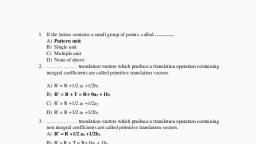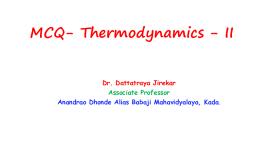Page 1 :
MCQ’s on, Unit II: Introduction to Thermal Engineering, 1. Which of the following laws was formulated by Nernst?, a. First law of thermodynamics, b. Second law of thermodynamics, c. Third law of thermodynamics, d. None of the above, Answer: (c), 2. Which of the following variables controls the physical properties of a perfect gas, (a) Pressure, (b) Temperature, (c) Volume, (d) all of the above, (e) Atomic mass., Answer: d, 3. The unit of temperature in S.I. units is, (a) Centigrade, (b) Celsius, (c) Fahrenheit, (d) Kelvin, (e) Rankine, Answer: d, 4. A closed system is one in which, (a) Mass does not cross boundaries of the system, though energy may do so, (b) Mass crosses the boundary but not the energy, (c) Neither mass nor energy crosses the boundaries of the system, (d) Both energy and mass cross the boundaries of the system, (e) Thermodynamic reactions take place., Answer: a, 5. Work done in a free expansion process is, (a) + Ve, (b) -Ve, (c) Zero, (d) Maximum, (e) Minimum., Answer: c, 6. An isolated system is one in which, (a) mass does not cross boundaries of the system, though energy may do so, (b) Neither mass nor energy crosses the boundaries of the system, (c) Both energy and mass cross the boundaries of the system, (d) mass crosses the boundary but not the energy, (e) Thermodynamic reactions do not occur., Answer: b, 7. Which of the following quantities is not the property of the system
Page 2 :
(a) Pressure, (b) Temperature, (c) Specific volume, (d) Heat, (e) Density, Answer: d, 8. Which of the following is not the intensive property, (a) Pressure, (b) Temperature, (c) Density, (d) Heat, (e) Specific volume., Answer: d, 9. The basis for measuring thermodynamic property of temperature is given by, (a) Zeroth law of thermodynamics, (b) First law of thermodynamics, (c) Second law of thermodynamics, (d) Third law of thermodynamics, (e) Avogadro’s hypothesis., Answer: a, 10. First law of thermodynamics furnishes the relationship between, (a) Heat and work, (b) Heat, work and properties of the system, (c) Various properties of the system, (d) Various thermodynamic processes, (e) Heat and internal energy., Answer: b, 11. According to first law of thermodynamics, (a) Work done by a system is equal to heat transferred by the system, (b) Total internal energy of a system during a process remains constant, (c) Internal energy, enthalpy and entropy during a process remain constant, (d) Total energy of a system remains constant, (e) Entropy of a system remains constant., Answer: d, 12. First law of thermodynamics, (a) Enables to determine change in internal energy of the system, (b) Does not help to predict whether the system will or not undergo a change, (c) Does not enable to determine change in entropy, (d) Provides relationship between heat, work and internal energy, (e) All of the above., Answer: e, 13. According to first law of thermodynamics, (a) Mass and energy are mutually convertible, (b) Carnot engine is most efficient, (c) Heat and work are mutually convertible, (d) Mass and light are mutually convertible
Page 3 :
(e) Heat flows from hot substance to cold substance., Answer: c, 14. Which device maintains a body at a temperature lowers than the temperature of the, Surroundings?, a) PMM1, b) PMM2, c) Refrigerator, d) Heat pump, Answer: c, 15. What does a refrigerant do?, a) Absorbs the heat leakage into body from surroundings, b) Evaporates in the evaporator, c) Absorbs latent heat of vaporization form the body which is cooled, d) all of the mentioned, Answer: d, 16. Coefficient of performance (COP) is defined as, a) Heat leakage/work input, b) Work input/heat leakage, c) Latent heat of condensation/work input, d) Work input/latent heat of condensation, Answer: a, 17. Which device maintains a body at a temperature higher than the temperature of the, Surroundings?, a) PMM1, b) PMM2, c) Refrigerator, d) Heat pump, Answer: d, 18. In a heat pump, there is heat leakage from the body to the surroundings., a) True, b) False, Answer: a, 19. What is the relation between COP of heat pump and refrigerator?, a) COP of pump=COP of refrigerator – 1, b) COP of pump=COP of refrigerator + 1, c) COP of pump=COP of refrigerator – 2, d) COP of pump=COP of refrigerator + 2, Answer: b, 20. Heat leakage from a heat pump to surroundings is always greater than work done on, pump., a) True, b) False, Answer: a, 21. Which of the following statements are true?
Page 4 :
a) A heat pump provides a thermodynamic advantage over direct heating, b) COP for both refrigerator and pump cannot be infinity, c) Work input for both refrigerator and pump is greater than zero, d) all of the mentioned, Answer: d, 22. Kelvin-Planck‟s and Clausius‟ statements are, a) Not connected to each other, b) Virtually two parallel statements of second law, c) Violation of one doesn‟t violate the other, d) None of the mentioned, Answer: b, 23. If one of the Kelvin-Planck’s or Clausius’s statements is violated, then other is also, violated., a) True, b) False, Answer: a, 24. A heat pump,, a) Extracts energy at low temperature heat source, b) Gives energy to high temperature heat source, c) Both of the mentioned, d) None of the mentioned, Answer: c, 25. Which of the following is true for a heat pump and a refrigerator?, a) A refrigerator removes heat to achieve cooling, b) A heat pump supplies heat at high temperature, c) Both of the mentioned, d) None of the mentioned, Answer: c, 26. The condenser and evaporator in vapour compression system are called cooler and, refrigerator respectively., a) True, b) False, Answer: a, 27. The COP of gas-cycle refrigeration cycle is very high., a) True, b) False, Answer: b, 28. In which phase of a substance does conduction mode of heat transfer take place?, a. solid, b. liquid, c. gaseous, d. all of the above, ANSWER: d. all of the above
Page 5 :
29. Mass transfer does not take place in, a. conduction heat transfer, b. convection heat transfer, c. radiation heat transfer, d. none of the above, ANSWER: c. radiation heat transfer, 30. What is the condition for conduction mode of heat transfer between two bodies?, a. the two bodies must be in physical contact, b. there must be temperature gradient between the bodies, c. both a. and b., d. none of the above, ANSWER: c. both a. and b., 31. In which mode, does the heat energy transfer between two bodies when they are, separated by some distance and there is no any medium between them?, a. conduction mode of heat transfer, b. convection mode of heat transfer, c. radiation mode of heat transfer, d. heat transfer cannot takes place with above condition, ANSWER: c. radiation mode of heat transfer, 32. The radiant heat emitted by anybody travels at the speed, a. less than the speed of light, b. more than the speed of light, c. equals to the speed of light, d. unpredictable, ANSWER: c. equals to the speed of light, 33. The conduction heat transfer with combination of transfer of material also is called as, a. material conduction heat transfer, b. convection heat transfer, c. solid convection heat transfer, d. none of the above, ANSWER: b. convection heat transfer, 34. The literature of heat transfer generally recognizes distinct modes of heat transfer. How, many modes are there?, a) One, b) Two, c) Three, d) Four, Answer: c, 35. Consider system A at uniform temperature t and system B at another uniform, temperature T (t > T). Let the two systems be brought into contact and be thermally, insulated from their surroundings but not from each other. Energy will flow from system A, to system B because of
Page 6 :
a) Temperature difference, b) Energy difference, c) Mass difference, d) Volumetric difference, Answer: a, 36. Unit of the rate of heat transfer is, a) Joule, b) Newton, c) Pascal, d) Watt, Answer: d, 37. Convective heat transfer coefficient doesn’t depend on, a) Surface area, b) Space, c) Time, d) Orientation of solid surface, Answer: a, 38. The rate equation used to describe the mechanism of convection is called Newton’s law, of cooling. So rate of heat flow by convection doesn’t depend on, a) Convective heat transfer coefficient, b) Surface area through which heat flows, c) Time, d) Temperature potential difference, Answer: c, 39. How many types of convection process are there?, a) One, b) Three, c) Four, d) Two, Answer: b, 40. Thermal conductivity is maximum for which substance, a) Silver, b) Ice, c) Aluminum, d) Diamond, Answer: d, 41. Which of the following is an example of forced convection?
Page 7 :
a) Chilling effect of cold wind on a warm body, b) Flow of water in condenser tubes, c) Cooling of billets in the atmosphere, d) Heat exchange on cold and warm pipes, Answer: b, 42. According to Stefan Boltzmann law, the total radiation from a black body per second, per unit area is directly proportional to the, A) Absolute temperature, B) Square of the absolute temperature, C) Cube of the absolute temperature, D) Fourth power of the absolute temperature, Answer: Option D, 43. In case of liquids and gases, the heat transfer takes place according to, A) Conduction, B) Convection, C) Radiation, D) None of these, Answer: Option B, 44. The radiation emitted by a black body is known as, A) Black radiation, B) Full radiation, C) Total radiation, D) All of these, Answer: Option D, 45. According to Newton's law of cooling, the heat transfer from a hot body to a cold body is, A) Directly proportional to the surface area, B) Directly proportional to the difference of temperatures between the two bodies, C) Either (A) or (B), D) Both (A) and (B), Answer: Option D, 46. Newtons law is given by, a) Q = h A (t s – tf), b) Q = 2 h A (ts – tf), c) Q = 3 h A (ts – tf), d) Q = 4 h A (ts – tf), Answer: a, 47. The Stefan-Boltzmann constant has units of, a) kcal/m2hr K4, b) kcal/m hr K4, c) kcal/hr K4, d) kcal/m2 K4, Answer: a, Explanation: According to Stefan-Boltzmann law, q = α A T4, , 48. According to Stefan-Boltzmann law of thermal radiation
Page 8 :
a) q = α A T, b) q = α A T4, c) q = α A T3, d) q = α A T5, Answer: b, Explanation: α is Stefan-Boltzmann constant whose value is 5.67 * 10 -8 W/m2 K4, 49. Calculate the radiant flux density from a black surface at 400 degree Celsius?, a) 1631.7 W/m2, b) 31.7 W/m2, c) 631.7 W/m2, d) 11631.7 W/m2, Answer: d, Explanation: E = σ T4 = 5.67 * 10 –8 (400 + 273)4 = 11631.7 W/m2, , 50. If the emitted radiant energy is to be doubled, to what temperature surface of black, body needs to be raised? Take radiant flux density as 11631.7 W/m 2., a) 894.4 K, b) 200.4 K, c) 800.3 K, d) 600.4 K, Answer: d, Explanation: 2(11631.7) = 5.67 * 10 –8T4, 51. A furnace having inside temperature of 2250 has a glass circular viewing of 6 cm, diameter. If the transmissivity of glass is 0.08, make calculations for the heat loss from the, glass window due to radiation, a) 234.54 W, b) 652.32 W, c) 328.53 W, d) 762.32 W, Answer: c Explanation: Q = σ A T4 (t) = 328.53 W., 52. The value of radiation coefficient or the Stefan-Boltzmann constant is, a) 5.67 * 10 -8 W/m2 K4, b) 5.67 * 10 -7 W/m2 K4, c) 5.67 * 10 -6 W/m2 K4, d) 5.67 * 10 -5 W/m2 K4, Answer: a, Explanation: q = α A T4, , 53. In a two stroke engine, the working cycle is completed in two revolutions of the, crankshaft., a) True, b) False, Answer: b, 54. A two stroke cycle engine gives _____________ the number of power strokes as compared, to the four stroke cycle engine, at the same engine speed., a) Half, b) Same, c) Double
Page 9 :
d) four times, Answer: c, 55. A two stroke cycle engine occupies larger floor area than a four stroke cycle engine., a) True, b) False, Answer: b, 56. A two stroke engine gives _____________ mechanical efficiency than a four stroke cycle, engine., a) Higher, b) Lower, c) Equal, d) None of the mentioned, Answer: a, 57. The two stroke cycle engine have lighter flywheel., a) True, b) False, Answer: a, 58. Thermal efficiency of a two stroke cycle engine is _____________ a four stroke cycle engine., a) Equal to, b) Less than, c) Greater than, d) None of the mentioned, Answer: b, 59. In a petrol engine, the mixture has the lowest pressure at the, a) Beginning of suction stroke, b) End of suction stroke, c) End of compression stroke, d) None of the mentioned, Answer: b, 60. The work required to overcome the friction of the exhaust and suction strokes is saved., a) True, b) False, Answer: a, 61. As there is a working stroke in every revolution, a more uniform turning moment is, obtained on the crankshaft and therefore, a __________ flywheel is required., a) Heavier, b) Slower, c) Lighter, d) None of the mentioned, Answer: c, 62. Two stroke engines are __________ than four stroke engines for the same power output, and speed., a) Heavier
Page 10 :
b) Slower, c) Lighter, d) None of the mentioned, Answer: c, 63. For the same output, two stroke engines occupy ___________ space., a) Greater, b) Lesser, c) Same, d) None of the mentioned, Answer: b, 64. The construction of a two stroke cycle engine is ____________ because it has ports instead, of valves., a) complex, b) Simple, c) unpredictable, d) None of the mentioned, Answer: b, 65. In case of two stroke engines because of scavenging, burnt gases remain in the, clearance Space as in case of four stroke engines, a) True, b) False, Answer: b, 66. In a four stroke cycle diesel engine, compression, a) Starts at 40o after bottom dead center and ends at 10o before top dead center, b) Starts at 40o before top dead center and ends at 40o after bottom dead center, c) Starts at top dead center and ends at 40o before bottom dead center, d) May start and end anywhere, Answer: a, 67. In a four stroke cycle diesel engine, the exhaust valve, a) Opens at 30o before bottom dead center and closes at 10o after top dead center, b) Opens at bottom dead center and closes at top dead center, c) Opens at 30o after bottom dead center and closes at 10o before top dead center, d) May open or close anywhere, Answer: a, 68. How can we classify steam generators on the basis of application?, a) Utility steam generators, b) Industrial steam generator, c) Marine steam generator, d) all of the mentioned, Answer: d, 69. Which of the following statement is correct?, a) A simple vertical boiler has one fire tube, b) A fire tube boiler occupies less space than a water tube boiler, for a given power
Page 11 :
c) Steam at a high pressure and in large quantities can be produced with a simple vertical, boiler, d) all of the mentioned, Answer: a, 70. In a fire-tube boiler, the water is in ___________, a) Tube, b) Shell, c) Drum, d) all of the mentioned, Answer: b, 71. In a water-tube boiler, water flows through?, a) Drum, b) Shell, c) Tube, d) None of the mentioned, Answer: a, 72. The boiler in which the tubes are surrounded by hot gases is called ___________, a) Fire tube boiler, b) Water tube boiler, c) Both fire and water tube boiler, d) None of the mentioned, Answer: b, 73. Which of these is not a type of steam generator depending upon the kind of, applications?, a) Utility steam generators, b) Marine steam generators, c) Agricultural steam generators, d) Industrial steam generators, Answer: c, 74. What is the critical pressure of steam in a utility steam generator?, a) 220.2 bar, b) 221.2 bar, c) 222.2 bar, d) 225.2 bar, Answer: b, 75. A definite area where some thermodynamic process takes place is known as, a) Thermodynamic System, b) Thermodynamic circle, c) Thermodynamic process, d) Thermodynamic laws, Answer: a





















































































